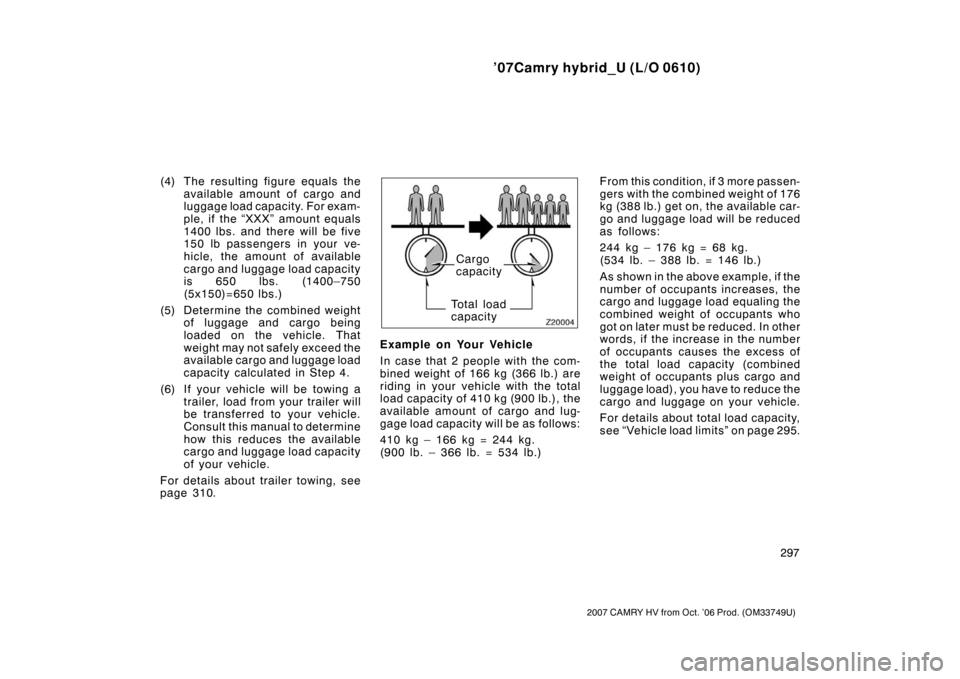Page 287 of 405

’07Camry hybrid_U (L/O 0610)
275
2007 CAMRY HV from Oct. ’06 Prod. (OM33749U)
Drive gently and avoid high speeds.
Your vehicle does not need an elaborate
break−in. But following a few simple tips
for the first 1600 km (1000 miles) can add
to the future economy and long life of
your vehicle:
�Avoid full throttle acceleration when
starting and driving.
�Avoid racing the hybrid system.
�Try to avoid hard stops during the first
300 km (200 miles).
�Do not drive for a long time at any
single speed, either fast or slow.
�Do not tow a trailer during the first 800
km (500 miles). FUEL TYPE
Your new vehicle must use only un-
leaded gasoline.
To help prevent gas station mix
−ups, your
Toyota has a smaller fuel tank opening.
The special nozzle on pumps with un-
leaded fuel will fit it, but the larger stan-
dard nozzle on pumps with leaded gas will
not.
At a minimum, the gasoline you use
should meet the specifications of ASTM
D4814 in the U.S.A. and CGSB 3.5 −M93
in Canada.NOTICE
Do not use leaded gasoline. Use of
leaded gasoline will cause the three�
way catalytic converter to lose its ef-
fectiveness and the emission control
system to function improperly. Also,
this can increase maintenance costs.
OCTANE RATING
Select Octane Rating 87 (Research Oc-
tane Number 91) or higher.
Use of unleaded gasoline with an octane
rating lower than 87 may result in engine
knocking. Persistent knocking can lead to
engine damage.
If your engine knocks...
If you detect heavy knocking even when
using the recommended fuel, or if you
hear steady knocking while holding a
steady speed on level roads, consult your
Toyota dealer.
However, occasionally, you may notice
light knocking for a short time while accel-
erating or driving up hills. This is normal
and there is no need for concern.
Break�in period Fuel
Page 307 of 405

’07Camry hybrid_U (L/O 0610)
295
2007 CAMRY HV from Oct. ’06 Prod. (OM33749U)
Vehicle load limits include total load
capacity, seating capacity, towing ca-
pacity and cargo capacity. Follow the
load limits shown below. Total load ca-
pacity and seating capacity are also
described on the tire and loading in-
formation label. For location of the tire
and loading information label, see
“Checking tire inflat ion pr es s ur e” on
page 359.
Total load capacity: 410 kg (900 lb.)
Total load capacity means com-
bined weight of occupants, cargo
and luggage. Tongue load is in-
cluded when trailer towing.
Seating capacity: Total 5 (Front 2, Rear 3)
Seating capacity means the maxi-
mum number of occupants whose
estimated average weight is 68 kg
(150 lb.) per person. Depending on
the weight of each person, the seat-
ing capacity given may exceed the
total load capacity.NOTICE
Even if the number of occupants are
within the seating capacity, do not ex-
ceed the total load capacity.
Towing capacity:
Toyota does not recommend towing
a trailer with your vehicle. It is not de-
signed for trailer towing.
Cargo capacity
Cargo capacity may increase or de-
crease depending on the size (weight)
and the number of occupants. For de-
tails, see “Capacity and distribution”
that follows.
CAUTION
Do not apply the load more than
each load limit. That may cause
not only damage to the tires, but
also deterioration to the steering
ability and braking ability, which
may cause an accident.
When stowing cargo and luggage in
the vehicle, observe the following:
� Put cargo and luggage in the trunk
when at all possible. Be sure all
items are secured in place.
� Be careful to keep the vehicle bal-
anced. Locating the weight as far
forward as possible helps maintain
balance.
� For better fuel economy, do not
carry unneeded weight.
Veh icle lo ad limit s Cargo and luggage—
—Stowage precautions
Page 309 of 405

’07Camry hybrid_U (L/O 0610)
297
2007 CAMRY HV from Oct. ’06 Prod. (OM33749U)
(4) The resulting figure equals theavailable amount of cargo and
luggage load capacity. For exam-
ple, if the “ XXX” amount equals
1400 lbs. and there will be five
150 lb passengers in your ve-
hicle, the amount of available
cargo and luggage load capacity
is 650 lbs. (1400–750
(5x150)=650 lbs.)
(5) Determine the combined weight of luggage and cargo being
loaded on the vehicle. That
weight may not safely exceed the
available cargo and luggage load
capacity calculated in Step 4.
(6) If your vehicle will be towing a trailer, load from your trailer will
be transferred to your vehicle.
Consult this manual to determine
how this reduces the available
cargo and luggage load capacity
of your vehicle.
For details about trailer towing, see
page 310.
Cargo
capacity
Total load
capacity
Example on Your Vehicle
In case that 2 people with the com-
bined weight of 166 kg (366 lb.) are
riding in your vehicle with the total
load capacity of 410 kg (900 lb.), the
available amount of cargo and lug-
gage load capacity will be as follows:
410 kg – 166 kg = 244 kg.
( 900 lb. – 366 lb. = 534 lb. ) From this condition, if 3 more passen-
gers with the combined weight of 176
kg (388 lb.) get on
, the av ailable car-
go and luggage load will be reduced
as follows:
244 kg – 176 kg = 68 kg.
( 534 lb. – 388 lb. = 146 lb. )
As shown in the above example, if the
number of occupants increases, the
cargo and luggage load equaling the
combined weight of occupants who
got on later must be reduced. In other
words, if the incr ease in the number
of occupants causes the excess of
the total load capacity (combined
weight of occupants plus cargo and
luggage load), you have to reduce the
cargo and luggage on your vehicle.
For details about total load capacity,
see “Vehicle load limits” on page 295.
Page 312 of 405
’07Camry hybrid_U (L/O 0610)
300
2007 CAMRY HV from Oct. ’06 Prod. (OM33749U)
STARTING AND DRIVING
Starting and driving
Preparing to start the hybrid system301
. . . . . . . . . . . . . . . . . . . . . . . . . .
How to start the hybrid system 301
. . . . . . . . . . . . . . . . . . . . . . . . . . . . . . .
Driving and parking using smart key system 304
. . . . . . . . . . . . . . . . . . .
Tips for driving in various conditions 307
. . . . . . . . . . . . . . . . . . . . . . . . . .
Winter driving tips 309
. . . . . . . . . . . . . . . . . . . . . . . . . . . . . . . . . . . . \
. . . . . .
Dinghy towing 310
. . . . . . . . . . . . . . . . . . . . . . . . . . . . . . . . . . . . \
. . . . . . . . . .
Trailer towing 310
. . . . . . . . . . . . . . . . . . . . . . . . . . . . . . . . . . . . \
. . . . . . . . . .
How to save fuel and make your vehicle last longer 311
. . . . . . . . . . . . .
SECTION 3
Page 322 of 405
’07Camry hybrid_U (L/O 0610)
310
2007 CAMRY HV from Oct. ’06 Prod. (OM33749U)
Depending on where you are driving,
we recommend you carry some emer-
gency equipment.
Some of the things you might put in the
vehicle are tire chains, window scraper,
bag of sand or salt, flares, small shovel,
jumper cables, etc.
Your vehicle is not designed to be
dinghy towed (with four wheels on the
ground) behind a motorhome.
NOTICE
Do not tow your vehicle with four
wheels on the ground. This may
cause serious damage to your vehicle.
Toyota does not recommend towing a
trailer with your Toyota. Toyota also
does not recommend the installation of
a tow hitch or the use of a tow hitch
carrier for a wheelchair, scooter, bi-
cycle, etc. Your Toyota is not designed
for trailer towing or for the use of tow
hitch mounted carriers.
Dinghy towingTrailer towing